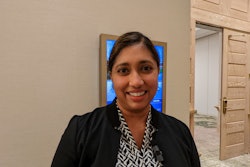AuntMinnie.com · Keeping up with the radiologists -- Episode 7: How IR promotes equity
How is interventional radiology an equity-promoting technology? What do host institutions need to know about creating a training program abroad? Are vendors interested in partnering in a global radiology effort? You will hear all this and more in Episode 7 of Keeping Up With the Radiologists.
AuntMinnie.com's latest podcast takes us to Africa, where humanitarians, healthcare professionals, and federal and state governments are all looking for ways to strengthen the healthcare workforce. The population in Nigeria alone, for example, exceeds 200 million.
More trained doctors and nurses leave to live and practice elsewhere, such as the U.K., than stay. "Ghost workers" reportedly get paid to work but don't actually contribute any services of value, a letter to The Guardian reported.
Nigerian policymakers have pushed mandatory service policies to deter the migration of healthcare workers out of the country, a BMJ Global Health blog reported in March. Nurses protested. Some dismiss the policies as a violation of personal rights to movement for personal gain, as well as inefficient and inequitable.
What does it take to strengthen the healthcare workforce?
This Penn Radiology AuntMinnie.com podcast features Nigeria's healthcare champion and interventional radiologist Ofonime "Fonzy" Ukweh, MD, with cardiothoracic radiologist Farouk Dako, MD; global IR enthusiast Stephen Hunt, MD, PhD; and radiology resident Monica Matsumoto, MD. Leading the conversation is Penn Radiology's own Saurabh "Harry" Jha with Mitch Schnall, MD, PhD.
Since this episode was recorded, the Federal Ministry of Health and Social Welfare for the Federal Republic of Nigeria inaugurated a National Emergency Medical Treatment Committee in late July, according to a health agency report.
In addition, the World Health Organization (WHO) and the Private Sector Health Alliance of Nigeria (PSHAN) officially launched a groundbreaking collaboration under the Adopt-A-Healthcare Facility Programme (ADHFP), the WHO announced on August 5. ADHFP aims to establish at least one global-standard Primary Healthcare Centre in each of the 774 local government areas, aligning with the guidelines of the Health Sector Renewal Investment Programme of the Federal Ministry of Health and the National Primary Health Care Development Agency, according to the report.
Progress is good news. The African region has the lowest density of doctors (about 2 per 10,000 population) and nursing and midwifery personnel (about 10 per 10,000 population), compared with the global median of 49 per 10,000, according to Dako, who has academic and filial links to Nigeria.
A cardiothoracic radiologist and assistant professor of radiology at the Hospital of the University of Pennsylvania, Dako penned an article in May on the growing healthcare worker migration to the U.S. and U.K., following a study of the drivers of global healthcare worker migration, published in the Journal of the American College of Radiology. Sub-Saharan Africa has spent billions of dollars to educate physicians now working elsewhere in destination countries.
"Brain drain," a term used to describe when skilled workers migrate to other countries, is one of the reasons why the WHO called for prioritizing 55 countries -- ranging from Haiti and Nigeria to Pakistan and Papua New Guinea -- for personnel development and system support, and discouraging active international recruitment of their personnel, according to Dako.
"Given the continued trend towards globalization and persistent U.S. dependence on foreign-trained workers, efforts to strengthen global health education and training should be a strategic U.S. priority, as well as an ethical and moral priority," Dako wrote in his article.
For interventional radiology training program leaders, potential host academic centers, vendors interested in partnership, and, especially, doctors and trainees considering mentorships in a distant program, the guest panel shares their experiences.
10 podcast points of interest
- In Nigeria, interventional radiologists are scarce but of growing importance, particularly in combating high maternal morbidity and post-surgical complications, the panel discusses. "Postpartum hemorrhage is one of the big issues," Hunt explains. "They simply don't have enough surgeons to deal with that issue." Improving outcomes not just for women, one interventional radiologist can support many surgeons. Hunt and colleagues explain how. Moreover, IR can start filling holes where there is a lack of basic surgical care. Installation of a C-arm alone could accelerate IR in a hopeful hospital.
- IR is unique, taking on a variety of complex image-guided tasks. "With skillsets that IR docs have developed, the wide range of procedures they can perform offers an incredible diversity of opportunities in a resource-constrained environment to treat a lot of diseases," explained Schnall. "That is something people should be paying attention to across the world, frankly even more in the U.S."
- Penn Radiology has been developing the infrastructure to support global engagement and IR training in the U.S. and internationally, according to Schnall. Toward more than a global IR village, which would itself be a feat, the effort will lead to a better understanding of the impact of various types of interventions.
- In a country like Nigeria, it takes political willpower, a local champion, and more to establish programs that will strengthen the healthcare workforce. Ukweh is well familiar and one such champion. During this episode, she explains what has kept her committed to building IR and capacity in Nigeria.
- "A lot of patients are suffering because there is no skillset," Ukweh shared, recalling a patient who had a tumor, who needed biliary drainage. This patient could possibly get a referral to India, but due to financial circumstances would not be able to get there. "We're building IR because everyone can't afford to access care abroad," Ukweh said.
- Early collaboration with a local partner that is involved in every step of the process moving forward is critical, explained Dako. "They need to be involved in creating the vision, and they need to have some skin in game. We often don't start with that step. Taking time to get that at a local institution and building them up and putting all our resources behind a local partner is the most important step." Dako also suggested creating a U.S.-based academic or nonacademic consortium to direct decommissioned equipment to under-resourced settings for building in-country capacity.
- An integrated interventional radiology resident and part of Penn's Radiology Health Equity Track, Monica Matsumoto, MD, shares her perspective. Among Matsumoto's credits include conducting a nationwide research survey of interventional radiology residents regarding their perceptions of and interests in global health work. Matsumoto also worked with RAD-AID to help launch a breast ultrasound program in Cusco, Peru. "I don't have a vast vision that I'm going to save the world, but we can provide some logistical support, some help with training on the ground, and increasing awareness," Matsumoto said. "Being involved as a trainee is a steppingstone to being involved later in our careers."
- Trainees may be more inclined to stay in under-resourced areas if educational partners establish research mentors and cross linkages to institutions and researchers in other parts of the world. With online and visiting groups and research-based teaching aligning with other parts of the world, trainees may not feel like they need to leave, like they're not missing out, Ukweh said. And, "in-person is irreplaceable," added Matsumoto.
- Egypt reversed its brain drain problem in radiology. Hunt explained how an interventional radiology practice there grew from four interventional radiologists 15 years ago to 120. Another practice highlighted is the high-end, smaller practice of Hammed Ninalowo, MD, in Lagos, Nigeria.
- "The training program is what forms the nucleus," explained Hunt, who discussed another key component: sustainability. "It's no good bringing over a Siemens unit or Philips if you don't have an engineer in-house ... [or you are not] able to make frequent trips to Nigeria to service." Schnall added that programs are being developed that utilize equipment that maintains a low profile in terms of support, or modest needs in terms of network support and energy, and that can work through a variety of energy infrastructure uptimes.
A final and intriguing point is that global radiology could be its own academic discipline -- very soon.
More impressions:
{02:49:23} High demand for IR
{13:04:22} Find a local champion
{17:59:06} Penn Medicine's global outreach
{19:46:12} Ofonime "Fonzy" Ukweh, MD
{23:45:19} Where to start a program
{26:08:10} Vendor involvement
{27:19:22} Stopping brain drain
{32:57:05} Practice examples
{40:30:12} Advocacy and collaborations
{45:47:17} Procurement
Guests:
Ofonime "Fonzy" Ukweh, MD, is an interventional radiologist from the University of Calabar, Nigeria.
Farouk Dako, MD, is a cardiothoracic radiologist with academic and filial links to Nigeria. Dako is director of global and population health research in radiology at Penn Medicine and codirects the Penn Radiology Global Health Imaging Case Competition focused on trainees in low- and middle-income countries. He is also the Nigeria program director and board member of RAD-AID International.
Stephen Hunt, MD, PhD, is a physician-scientist at Penn Medicine and an assistant professor of radiology at the Hospital of the University of Pennsylvania. Hunt codirects the Penn Image-Guided Interventions Laboratory and has worked abroad for global radiology outreach.
Monica Matsumoto, MD, is a fourth-year resident and integrated interventional radiology resident at the University of Pennsylvania. Matsumoto fosters the development of critical radiology services in under-resourced settings through education, research, and collaboration.
Hosts:
Saurabh (Harry) Jha, MD, is an associate professor of radiology at the Hospital of the University of Pennsylvania. Jha obtained a master’s degree in health policy research from the Leonard Davis Institute at the University of Pennsylvania. He earned his medical degree from the United Medical and Dental Schools of Guy’s, King’s, and St. Thomas’ Hospitals. Jha developed Value of Imaging, a set of radiology educational resources.
Mitchell Schnall, MD, PhD, is a physician at Penn Medicine in its abdominal imaging services program. Chair of the department of radiology and the Eugene P. Pendergrass Professor of Radiology at the Perelman School of Medicine, Schnall has served as the group co-chair of the ECOG-ACRIN Cancer Research Group since its founding in 2012. He is an international leader in translational biomedical and imaging research, working throughout his career across the interface between basic imaging science and clinical medicine to ensure effective integration of radiology research with other medical disciplines.
This episode of Keeping Up With the Radiologists is brought to you by AuntMinnie.com in collaboration with Penn Radiology. The series is also available on Spotify, YouTube Music, Apple Podcasts. Check back for new episodes!




















